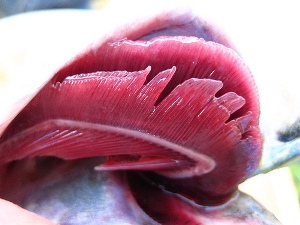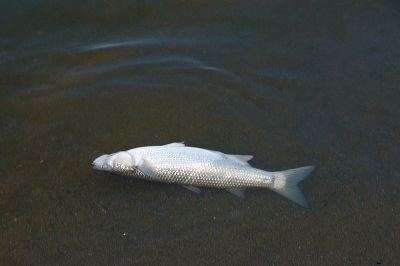Luxilus cornutus - BIO203
Some Fish Anatomy
Fish have numerous adaptations to the habitat in which they live that are conserved through most species. I will talk about a few here in more depth that I find quite interesting. Keep in mind that this is just a broad overview of a few adaptations that Luxilus cornutus has in common with most other fish species.
Breathing Under Water
 One of the most important adaptations that fish have evolved over time
is their obvious ability to breath under water. Ever wonder how a fish
can actually do this? Well it all starts with the fish's gills. Gills
are small extensions from the body that aid in the gathering and removal
of oxygen from water. All fish species with gills have them on both
sides of their head, 4 gill arches, and lots of fillaments on the gills
that allow for increased surface area for gas exchange. The common
shiner has a muscle just outside the gills that is called an opercula,
which aids in the movement of water into the gill. Once the water
reaches the gills, it
participates in a process known as counter-current exchange. This means
that the oxygen rich water will flow over the gills in an opposite
direction of the oxygen poor blood. This results in a diffusion gradient
that is always set for the exchange of water INTO the gills at
a high rate and never
One of the most important adaptations that fish have evolved over time
is their obvious ability to breath under water. Ever wonder how a fish
can actually do this? Well it all starts with the fish's gills. Gills
are small extensions from the body that aid in the gathering and removal
of oxygen from water. All fish species with gills have them on both
sides of their head, 4 gill arches, and lots of fillaments on the gills
that allow for increased surface area for gas exchange. The common
shiner has a muscle just outside the gills that is called an opercula,
which aids in the movement of water into the gill. Once the water
reaches the gills, it
participates in a process known as counter-current exchange. This means
that the oxygen rich water will flow over the gills in an opposite
direction of the oxygen poor blood. This results in a diffusion gradient
that is always set for the exchange of water INTO the gills at
a high rate and never into the water. As seen above, although both
concentrations of oxygen are close as they pass over each other, it will
always be higher in the water; thus favoring diffusion into the
capillaries. As seen in concurrent exchange, the diffusion process
starts off great, but soon, both concentrations will reach near fifty
percent and no more diffusion will take place, resulting in a dramatic
decrease in
efficiency.
into the water. As seen above, although both
concentrations of oxygen are close as they pass over each other, it will
always be higher in the water; thus favoring diffusion into the
capillaries. As seen in concurrent exchange, the diffusion process
starts off great, but soon, both concentrations will reach near fifty
percent and no more diffusion will take place, resulting in a dramatic
decrease in
efficiency.
The Swim Bladder
The swim bladder is an organ seen in nearly all fish species (except
early fishes such as sharks and rays) that has a very diverse usage
between species and even within each organism. The swim bladder is a
gas, mostly oxygen, filled sac in its body cavity. Oxygen arrives in the
swim bladder by means of diffusion from the blood. One of the main
usages of the swim bladder is to keep a fish afloat. The "overall
density" of a fish is higher than that of freshwater, so it must have a
way of somehow preventing itself from constantly sinking. One way to do
this is by swimming all the time, and creating a "dynamic lift" from the
buoyancy of the
 water. The other way is to use "neutral buoyancy" via
the swim bladder. Since the swim bladder is full of oxygen, it has a
life preservative type function, by allowing the fish to fill the bladder with air and thus able to float.
The swim bladder is also the reason why a dead fish floats bottom up.
The bladder is located just below the center of gravity in a fish.
Because of this, when the fish dies and the swim bladder becomes
nonfunctional, it will float upside down!
water. The other way is to use "neutral buoyancy" via
the swim bladder. Since the swim bladder is full of oxygen, it has a
life preservative type function, by allowing the fish to fill the bladder with air and thus able to float.
The swim bladder is also the reason why a dead fish floats bottom up.
The bladder is located just below the center of gravity in a fish.
Because of this, when the fish dies and the swim bladder becomes
nonfunctional, it will float upside down!
This concept of filling the bladder with air to allow the fish to stay
floating is also an important concept in allowing the fish to move up or
down in the water column. If a fish needs to move vertically in the
water, the release or retention of air is critical. How fish monitor the
distension of the swim bladder is not entirely known, but stretch
receptors are thought to play a possible role. It has been measured that
fish can sense a change in depth close to 0.1% of it's current position
as long as it is near the surface (Bone and Moore, 120). This means that
if it was 100 meters deep in water, it could sense a change in depth of
about 10cm!
Since the swim bladder will change its volume and its pressure, it is
also known to play a factor in hearing and sound production.
Go back home, or find out how and what the shiner eats.